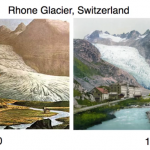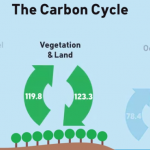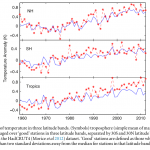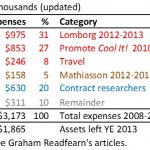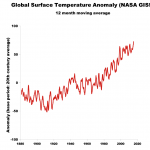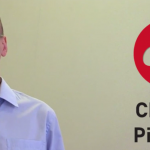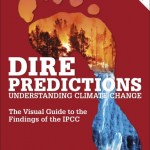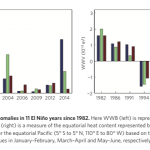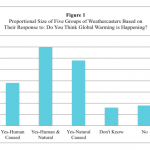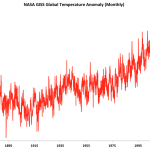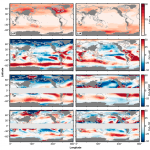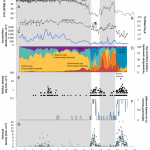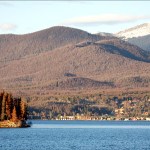Global Warming
... because it is Paleo!
Paleo data, models, expectations, observations, about the past and to some extent the future. The Little Ice Age. The Hockey Stick. And, what people get wrong about it all.
Denial101x Making Sense of Climate Science Denial goes paleo (and Medieval) this week. Here is a sample video, Andy Skuce on the Little Ice Age:
Peter Jacobs employs a great analogy of encountering a dangerous bear in the woods to help us understand palaeoclimatology.
Professor Tim Osborn, Professor Michael Mann, Professor Katrin Meissner, Professor Dan Lunt and Professor Isabella Velicogna get…
A few notes from Week 3 of Denial 101x: Making Sense of Climate Science Denial. These notes are mainly about the science and not the denialism part (unlike my last post, which addressed the central theme of the course, denialism, more.)
The Carbon Cycle
Atmospheric CO2 concentrations have gone up by about 40%. Simple explanation: Humans are releasing Carbon into the atmosphere by burning fossil fuel. More complex explanation: Humans are affecting the Carbon Cycle in a number of ways, releasing Carbon (burning fossil fuels) as well as affecting natural Carbon sinks.
This became known,…
Note: The original title of this post was "A Global Warming Fingerprint Confirmed: Upper Troposphere Warming" because I was thinking that upper troposphere warming was a fingerprint. John Cook contacted me to let me know that he didn't think it was. The reason it is not is that more than one thing can cause upper tropospheric warming, not just AGW. However, it does turn out to be more complicated than that. Various people claiming that a lack of UT warming was evidence of no warming have now been shown wrong, but even a lack of warming is not, if you will, an anti-AGW fingerprint. In the…
Bjorn Lomborg has written an Op Ed in the Wall Street Journal lamenting the decision of the University of Western Australia (UWA) to nix previously developed plans to accept a $4 million dollar payment from the conservative Australian government, to be matched by university money, to implement a version of Lomborg’s Copenhagen Institute there, to be known as Australia Consensus.
See: Bjorn Lomborg Is Wrong About Bangladesh And Sea Level Rise
See: Bjørn Lomborg WSJ Op Ed Is Stunningly Wrong
See: Are electric cars any good? Lomborg says no, but he’s wrong.
Lomborg’s scholarship in the area of…
Global warming is typically measured at the surface, with data from thermometers all across the land areas and sea surface temperatures combined. That isn't the whole story, of course. Much of the added heat, an effect of human generated greenhouse gas pollution, goes into the upper 2,000 meters or so of the ocean. But we use the surface measurements to track global warming because we have the data for a long period of time, and those data in turn have been linked to longer running but less precise paleo data.
Almost every month for way over a year now has been warm, and April 2015 is no…
The Earth's climate is warming. The upper oceans are warming, the sea surface temperatures are elevated, the air in the lower Troposphere, where we live, is warming. This warming is caused almost entirely by the increase in human generated greenhouse gasses and the positive (not positive in a good way) feedbacks caused by that. The effects that increase the global heat imbalance and the effects that decrease it (such as greenhouse gas increase and aerosols -- dust -- from volcanoes, respectively) vary over time in their effect, which causes some variation in the upward march of global…
I'm auditing the EdEx course "Denial101x: Making Sense of Climate Science Denial." This is Week 2: Global Warming ins Happening. The course is covering indicators of warming, what is happening in the Cryosphere, and related matters.
Here is an example lecture segment:
A central theme of this week is the relationship between climate and weather, and how this relationship becomes fodder for the development of myths in service of denial about climate change. The climate is a cherry orchard. Weather is the cherries. Don't pick the cherries!
There are many dimensions the climate system that…
I recently noted that there are reasons to think that the effects of human caused climate change are coming on faster than previously expected. Since I wrote that (in late January) even more evidence has come along, so I thought it was time for an update.
First a bit of perspective. Scientists have known for a very long time that the proportion of greenhouse gasses in the Earth’s atmosphere controls (along with other factors) overall surface and upper ocean heat balance. In particular, is has been understood that the release of fossil Carbon (in coal and petroleum) as CO2 would likely warm…
Dire Predictions: Understanding Global Warming by Michael Mann and Lee Kump is everyperson’s guide to the latest Intergovernmental Panel on Climate Change (IPCC) report. The IPCC issues a periodic set of reports on the state of global climate change, and has been doing so for almost two decades. It is a massive undertaking and few have the time or training to read though and absorb it, yet it is very important that every citizen understands the reports’ implications. Why? Because human caused climate change has emerged as the number one existential issue of the day, and individuals,…
I recently posted an overview of a new climate study, Comparing the model-simulated global warming signal to observations using empirical estimates of unforced noise, by Patrick T. Brown, Wenhong Li, Eugene C. Cordero & Steven A. Mauget. That study is potentially important because of what it says about how to interpret the available data on global warming caused by human generated greenhouse gas pollution. Also, the since publication the study has been rather abused by climate contrarians who chose to interpret it very inaccurately. This is addressed in this item by Media Matters.
My…
A group of scientists attending a major conference get together in a bar. They talk, but they agree on nothing because they are critical academics. The server comes along to take the beer order and says, "I noticed you all are constantly arguing. What are you arguing about?"
"Sensitivity," one of them says. "It is the number of degrees C the Earth's surface will warm with a doubling of CO2 in the atmosphere. Is it 2, 3, 4? ... We cant settle on a number"
The server considers their plight for a moment. Suddenly, she rips several sheets out of her order book and hands one to each of the…
That is a good question, and difficult to answer. If it turns out to be, it will be the warmest calendar year in the instrumental record, which goes back into the 19th century.
Regardless of what El Nino (ENSO) does, 2015 will be a warm year. Why? Because everything is warm and getting warmer and even if 2015 is less warm than 2014, it will be warm. There is no other possibility.
Even without the effects of El Nino, though, it is possible that 2015 will be warmer than 2014 because we see a lot of heat out there. If the present, relatively weak El Nino continues for a while, it will likely…
This is Part I of a two part treatment of new research on climate change. Part II is here.
There is a new paper out, Comparing the model-simulated global warming signal to observations using empirical estimates of unforced noise, by Patrick T. Brown,Wenhong Li, Eugene C. Cordero & Steven A. Mauget. It is potentially important for two reasons. One is because of what it says about how to interpret the available data on global warming caused by human generated greenhouse gas pollution. The other is because of the way in which the results are being interpreted, willfully or through…
The American Biology Teacher has hosted a guest editorial by Glenn Branch and Minda Berbeco of the NCSE. The editorial points out that climate science is under a similar sort of anti-science attack as evolution has been for years, though generally with different (less religious) motivations. Also noted is the problem of fitting climate change into the curriculum, especially in biology classes. Indeed, biology teachers are already having a hard time getting the standard fare on the plate. In recent years, for example, the AP biology curriculum has jettisoned almost everything about plants…
A new study seems to provide a better way to categorize El Nino climate events, and offers an explanation for how different kinds of El Nino events emerge.
El Nino is part of a large scale, very important climate phenomenon in the Pacific Ocean, generally referred to as the El Nino Southern Oscillation (ENSO). Over time (years) wind and water currents move heat into the upper levels of the Equatorial Pacific (La Nina). Then, over time (months) the heat comes back out – that is an El Nino. The effects can be dramatic. During El Nino years, trade winds and monsoons may behave differently than…
There was a time when I picked which local TV news station to watch based on the way the TV meteorologist addressed global warming. There were two stations in the running. One of them had a guy who frequently disparaged climate science, and the other had Paul Douglas, who no longer does TV meteorology (I no longer watch local TV news) but who has become a major spokesperson for reason and science (see: Paul Douglas on Climate Change and A Q&A with Paul Douglas, the evangelical Christian Republican poster boy for climate change). Paul and I have become colleagues and friends.
In 2011,…
The last 12 months have been the warmest one year period in the NASA database since records began in 1880. According to the just released NASA GISS Global Temperature Data, March, 2015 is estimated to have been the fifth warmest month on record. Here are the top 20 months in rank order:
2007JAN93
2002MAR88
2010MAR87
1998FEB86
2015MAR84
2010APR82
2014SEP81
2015FEB78
2014MAY78
2014OCT77
2005OCT76
2015JAN75
2013NOV75
2010NOV75
1998JUN75
1995FEB75
2010FEB74
2006DEC74
2014DEC73
2014AUG73
Here is the monthly data covering the entire period of the instrumental record (1880 - present)
And, most…
Maybe, maybe not. There is a new paper that looks at what climate scientists call “synoptic midlatitude temperature variability” and the rest of us call “cold snaps” and “heat waves.” The term “synoptic” simply means over a reasonably large area like you might expect a cold snap or heat wave to be. Specifically, the paper (Physics of Changes in Synoptic Midlatitude Temperature Variability, by Tapio Schneider, Tobias Bischoff and Hanna Plotka, published in Journal of Climate) concludes that as human-caused greenhouse gas pollution increases, the frequency of cold snaps in the northern…
A new study by Sarah Moffitt, Tessa Hill, Peter Roopnarine, and James Kennett (Response of seafloor ecosystems to abrubt global climate change) gets a handle on the effects of relatively rapid warming and associated Oxygen loss in the sea on invertebrate communities. The study looked at a recent warming event (the end of the last glacial) in order to understand the present warming event, which is the result of human-caused greenhouse gas pollution.
Here is what is unique about the study. A 30 foot deep core representing the time period from 3,400 to 16,100 year ago, was raised from a site in…
There is some interesting new work carried out by researchers at Dartmouth College and the USDA Forest Service on the relationship between the Mountain Pine Beetle, major die-offs of forests in North America, and climate change.
The Mountain Pine Beetle (Dendroctonus ponderosae) is a kind of “bark beetle” (they don’t bark, they live in bark) native to western North America. They inhabit a very wide range of habitats and are found from British Columbia all the way south to Mexico. In British Columbia alone, the pine beetle, though a fairly complex process, has managed to destroy 16 of 55…
